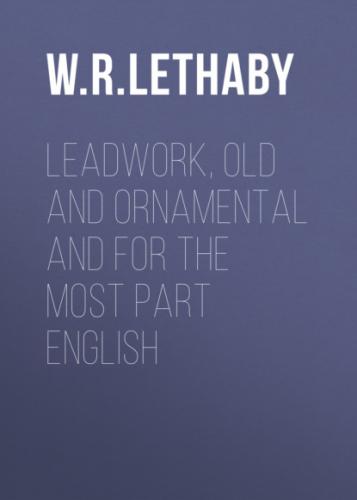W. R. Lethaby
Leadwork, Old and Ornamental and for the most part English
Published by Good Press, 2021
EAN 4064066186586
Table of Contents
§ I. OF MATERIAL AND CRAFTSMANSHIP.
§ III. OF LEAD COVERINGS TO BUILDINGS.
§ IV. OF LEADED SPIRES AND TURRETS.
§ X. OF THE DECORATION OF LEAD.
§ XI. OF LEAD ORNAMENTATION OF OTHER MATERIALS.
§ XVI. OF VASES AND GATE PIERS.
§ XVII. OF FINIALS AND CRESTINGS.
§ XX. OF PIPES AND PIPE HEADS.
Messrs. MACMILLAN & CO.’S BOOKS FOR TECHNICAL CLASSES.
ELEMENTARY SCIENCE CLASS BOOKS.
SOME VOLUMES OF “NATURE” SERIES.
LEADWORK
§ I. OF MATERIAL AND CRAFTSMANSHIP.
To none of the processes of modern mechanism do more vulgar associations cling than to “Plumbing.” It is the very serviceableness and ductility of lead as a material that have brought about the easy and familiar contempt with which it is treated. While few are more worthy of artistic care no metal is more perfectly adaptable to noble use through a range of treatments that cannot be matched by any other metal whatsoever. It combines extreme ease of manipulation with practically endless durability, and a suitability to any scale, from a tiny inkwell, or a medal, to the statue of horse and rider, a Versailles fountain, or the greatest cathedral spire.
The range of method in handling follows from the equal ease with which it can be hammered out, cast, or cut, and all three, employed concurrently on the same piece.
The main purpose of the pages which follow is not to set out a history of the use of this material in various forms, although this is involved. It is intended by pointing out the characteristics and methods of the art of lead working in the past to show its possibilities for us, and for the future. A picture of what has been done is the best means of coming to a view of what may again be done. But it cannot be too strongly asserted that the forms of past art cannot be copied; that certain things have been done is evidence enough to show that we cannot do them over again. Reproduction is impossible; to attempt it is but to make a poor diagram at the best.
Commercially produced imitations of ornamental works are infinitely beneath the merely utilitarian object which serves its purpose and attempts nothing more. Behind all design there must be a personality expressing himself; but certain principles of treatment and methods of working may be understood in some degree by a study of past work without going all through it again. History thus makes the experience of the past available to us, but it does not relieve us of the necessity of ourselves having experiences. There is a great stimulus in feeling one of a chain, and entering into the traditions of a body of art. The workman Bezin said to Mr. Stevenson of museums, “One sees in them little miracles of workmanship—it fires a spark.”
New design must ever be founded on a strict consideration of the exact purpose to be fulfilled by the proposed object, of how it will serve its purpose best, and show perfect suitability to the end in view when made in this or that material by easy means. This, not the torturing of a material into forms which have not before been used, is the true ground of beauty, and this to a certain extent is enough without any ornamentation. Ornament is quite another matter, it has no justification in service, it can only justify itself by being beautiful.
In so far as history is involved here it has been necessary to refer to and to figure many works, not bearing the impress of a fine living style, but only passable exercises in the respectabilities of a sort of conventional design learnt by rote. As a general rule it will be found that the workers of the middle ages penetrated at once to the reason of a thing in structure and then decorated it with an evidence of fresh thought—a delight in growth, form, humanity, in one word Nature, the source of all beauty and subject of all art. Each thing made is evidently by an artist; it expresses reasonable workmanship and happy thought in pleasant solution of some necessity of actual service. Many of the later things are not thus natural and spontaneous but pedantic and pompous, fulfilling their chief intention if they were expensive; while to-day the chief care of design is often to appear expensive without being so in fact.
Only
